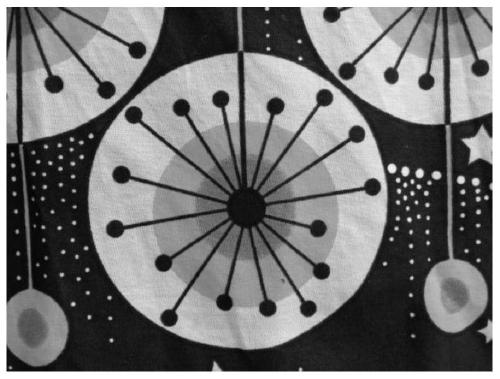Cation modified printing washing and anti-staining process of cellulose fiber fabrics
A cellulose fiber and cationic technology, applied in the field of textile printing, can solve the problems of cross-color, no anti-staining, etc.
- Summary
- Abstract
- Description
- Claims
- Application Information
AI Technical Summary
Problems solved by technology
Method used
Image
Examples
Embodiment 1
[0017] Water-washing and anti-staining process of cationic modified printing of cellulose fiber fabrics, including the following processes:
[0018] (1) Cationic modification process:
[0019] Prepare modifier 3-chloro-2-hydroxypropyltrimethylammonium chloride 120g / L and sodium hydroxide solution 20g / L and mix evenly, then pad the fabric, fabric specification 40×40, 133×72, one After soaking and rolling, the liquid-carrying rate is 80%, stacked at room temperature for 24 hours, washed with cold water, washed twice with hot water, washed with cold water, neutralized with 2g / L citric acid solution, washed with cold water, and dried.
[0020] (2) Reactive dye printing process: adopt conventional process reactive dye printing.
[0021] (3) Washing process after printing:
[0022] Prepare 4.5kg of washing bottom liquid and place it in three washing tanks, each washing tank is 1.5kg. The temperature is constant at 60°C, and the cloth feeding speed is 80m / min. The first washing t...
Embodiment 2
[0032] Water-washing and anti-staining process of cationic modified printing of cellulose fiber fabrics, including the following processes:
[0033] (1) Cationic modification process:
[0034] Prepare modifier 2,3-epoxypropyltrimethylammonium chloride 100g / L and sodium hydroxide solution 20g / L and mix evenly, then pad the fabric, fabric specifications 40×40, 133×72, one dip After one rolling, the liquid-carrying rate is 60%, stacked at room temperature for 24 hours, washed with cold water, washed twice with hot water, washed with cold water, neutralized with water with 2g / L citric acid solution, washed with cold water, and dried.
[0035] (2) Reactive dye printing process: adopt conventional process reactive dye printing.
[0036] (3) Washing process after printing:
[0037] Prepare 4.5kg of washing bottom liquid, the concentration of the washing liquid bottom liquid is 8g / L, put it in three washing tanks, each washing tank is 1.5kg, the temperature of the washing liquid is ...
Embodiment 3
[0041] Water-washing and anti-staining process of cationic modified printing of cellulose fiber fabrics, including the following processes:
[0042] (1) Cationic modification process:
[0043] Prepare modifier 2,3-epoxypropyltrimethylammonium chloride 130g / L and sodium hydroxide solution 20g / L and mix evenly, then pad the fabric, fabric specifications 40×40, 133×72, one dip After one rolling, the liquid-carrying rate is 100%, stacked at room temperature for 24 hours, washed with cold water, washed twice with hot water, washed with cold water, neutralized with water with 2g / L citric acid solution, washed with cold water, and dried.
[0044] (2) Reactive dye printing process: conventional reactive dye printing is adopted.
[0045] (3) Washing process after printing:
[0046] Prepare 4.5kg of washing bottom liquid, the concentration of the washing liquid bottom liquid is 20g / L, put it in three washing tanks, each washing tank is 1.5kg, the temperature of the washing liquid is c...
PUM
 Login to View More
Login to View More Abstract
Description
Claims
Application Information
 Login to View More
Login to View More - R&D
- Intellectual Property
- Life Sciences
- Materials
- Tech Scout
- Unparalleled Data Quality
- Higher Quality Content
- 60% Fewer Hallucinations
Browse by: Latest US Patents, China's latest patents, Technical Efficacy Thesaurus, Application Domain, Technology Topic, Popular Technical Reports.
© 2025 PatSnap. All rights reserved.Legal|Privacy policy|Modern Slavery Act Transparency Statement|Sitemap|About US| Contact US: help@patsnap.com

